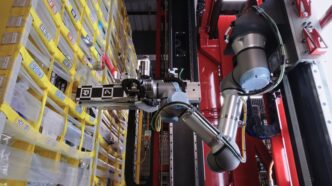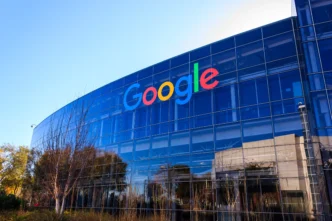Amazon has introduced a new intelligent warehouse robot named Vulcan, capable of using force sensors to “feel” items as it organizes and retrieves them. This latest innovation is part of Amazon’s push to enhance safety and efficiency across its fulfillment centers while continuing to expand its robotics capabilities.
Vulcan Robot Uses Touch and Vision to Boost Warehouse Precision
Vulcan is a two-armed robotic system. One arm focuses on moving and rearranging products within shelving units. The other arm, equipped with a camera and suction cup, is responsible for identifying and picking items. What sets Vulcan apart is its ability to sense contact with objects using advanced force sensors, allowing it to grasp delicate or irregularly shaped items with more care.
According to Amazon, Vulcan was trained using real-world tactile data, including touch and pressure feedback. This training allows the robot to handle approximately 75% of items in Amazon’s inventory, a significant leap in robotic handling capabilities. Moreover, Vulcan is designed to improve its performance over time by learning from its experiences on the warehouse floor.
The robot has already been deployed in two of Amazon’s locations — Spokane, Washington, and Hamburg, Germany — where it has processed over 500,000 customer orders so far. This demonstrates Vulcan’s scalability and real-world effectiveness in live operations.
Robotics Expansion Sparks Debate Over Human Roles
Amazon now uses hundreds of thousands of robots in its global warehouses. Vulcan joins other advanced machines already deployed to speed up operations and minimize errors. However, the company’s investment in robotics has drawn criticism from labor advocates who worry these machines could eventually replace human workers.
Amazon, however, insists that Vulcan and other robotics are designed to assist human employees, not replace them. The company says that automation can take over repetitive or physically demanding tasks, reducing the risk of injury and freeing workers to focus on more strategic roles.
In a statement, Amazon emphasized safety: “Robots like Vulcan are not about replacing people. They are part of our effort to make fulfillment centers safer and more efficient.”
This latest move aligns with Amazon’s long-term automation strategy. As consumer demand and order volumes grow, the company continues to explore how machine learning, computer vision, and robotics can streamline the complex process of warehousing and logistics.
By building robots that mimic human capabilities — such as touch and learning — Amazon is pushing the boundaries of what automated systems can do in dynamic environments. Vulcan’s mix of mechanical precision and sensory intelligence may pave the way for broader uses of AI-powered robotics in retail logistics.













